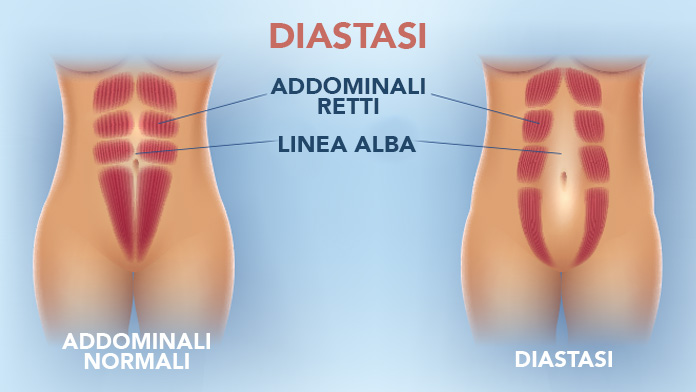However, it may happen that after childbirth not everything goes back to the way it was before. The abs no longer seem to hold, despite efforts to train them, and in some cases it forms a kind of leather apron that slips below the navel, unsightly and resistant to any diet effort.
In fact, diet and classic physical exercise can do very little, because a belly that feels no reason to get back in place is not a matter of fat or loss of tissue tone, but the consequence of a deeper problem: the removal of the rectus abdominis muscles, that kind of two columns that run through the center of the abdomen from the sternum to the pubis. It is technically called abdominal diastasisa condition that affects above all, even if not exclusively, women who have given birth, even more if with Caesarean section.
Abdominal diastasis: first and second stage
Normally, the rectus abdominis muscles, parallel to each other, are joined by a small fibrous plate, called sunrise line, from a few millimeters to a centimeter to a centimeter and a half wide. From an anatomical point of view, diastasis is the removal of the muscles and the consequent enlargement of this lamina. “In this situation an area of weakness is created, and it is the first stage of diastasis: the tissues are only partially intact and the muscles are too far apart to function properly and protect the abdomen”, he explains Giampiero CampanelliProfessor of Surgery at the University of Insubria and Director of the General Surgery Unit, Day & Week Surgery section of the IRCCS Galeazzi Hospital – Sant’Ambrogio.
«It is a paraphysiological condition that in most cases only gives cosmetic problems. However, if the separation of the muscles is such as to stretch the linea alba until it yields, then a hole can be createdand this is the second stage of the problem: the aesthetic consequences are more relevant, and in some cases a hernia may form (epigastric or umbilical), which gives pain and needs to be treated like all hernias».
Abdominal diastasis: tthird and fourth stage
Even more annoying is the third stage, in which the size of the hernia can be greater, and even externally there are very visible consequences: swelling evident, stretch marks on the skin and belly falling down from below the navel. “That’s what I call it “floppy abdomen post partum” (literally “flabby belly after childbirth”), since it occurs almost exclusively in women who have given birth”, continues the expert. «In this case, possible hernias can be associated spine problemsbecause patients tend to assume an incorrect posture, with their shoulders bent forward».
Finally, in the fourth stage, the belly relaxation becomes even more noticeable, and also spreads between the navel and breastbone. Many very thin patients with diastasis so important that you can see the viscera under the skin of the belly, an extreme situation that we treat with a targeted intervention», says Campanelli.
For less severe cases: the Tupler method
For less serious cases, they may even be enough targeted gymnastics to contain, if not even improve, the situation. The method devised by the American nurse is particularly effective Julie Tupler: are exercises that aim at strengthen the oblique and transverse abswithout straining the straight abs. The reason is simple: if the rectus muscles are stimulated, which are no longer parallel, but in a V shape, with the base of the V towards the pubis, the central hole widens during the contraction, and therefore the diastasis worsens. Correct gymnastics consists in the alternating contraction of the oblique and transverse muscles, on one side and on the other, with correct breathing, simultaneously drawing in the navel towards the center.
For the most serious cases: tailor-made surgery
«If the problem is substantially aesthetic but there are no hernias or floppy abdomen, nor problems of a postural or functional nature on the spine, surgical intervention can be reconnect the rectus and, if necessary, place a net behind the muscles to reinforce the structure. The intervention can be laparoroboticoless invasive but more expensive, or in laparoendoscopywith a small supraumbilical incision».
«If, on the other hand, there is also the floppy abdomen, it is associated with the surgery to bring the rectus muscles closer together the abdominoplasty, that is, the removal of excess cutaneous and subcutaneous apron. In the end, the aesthetic result is excellent because there is a deep reconstruction of the abdomen, and at the same time a flattening of the belly. And after the intervention, whatever it is, immediately gymnastics and a healthy standard of living to maintain the result obtained ». In many regions, for severe diastasis and/or hernia, the operation is reimbursed by the National Health Service.
Read also…
None found
